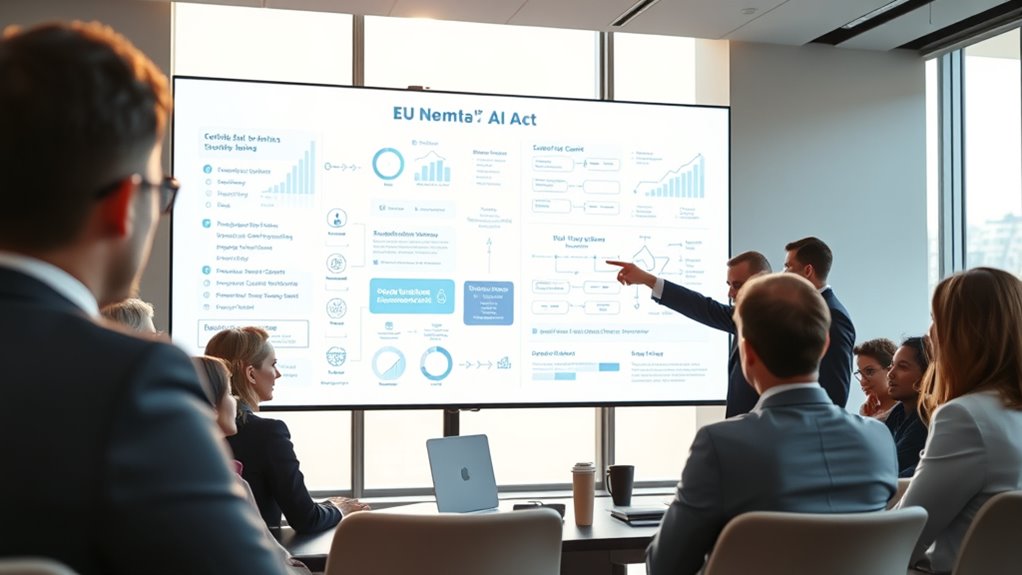The EU AI Act classifies AI systems by risk level—unacceptable, high, limited, and minimal—each with specific rules to guarantee safety, ethics, and fundamental rights. High-risk AI, like biometric recognition, requires strict controls, transparency, and ongoing monitoring, while lower-risk systems have fewer obligations. Developers and users must follow data security, transparency, and compliance measures, with enforcement actions for violations. Continue exploring to understand how these rules shape responsible AI use and innovation across Europe.
Key Takeaways
- The EU AI Act classifies AI systems into four risk categories, emphasizing ethical standards and fundamental rights.
- High-risk AI requires strict measures like bias mitigation, continuous monitoring, and thorough testing before deployment.
- Transparency obligations mandate clear communication about AI functions, decision processes, and user instructions.
- Data security and compliance monitoring involve detailed documentation, regular audits, and enforcement actions for violations.
- The regulation promotes innovation through sandboxes, incentives, and adaptable pathways for startups and SMEs.
Scope and Applicability of the EU AI Act

The scope and applicability of the EU AI Act determine which AI systems fall under its regulatory framework. If you develop or deploy AI that impacts individuals or society within the EU, it likely falls within this scope. The Act emphasizes ethical considerations, ensuring AI promotes fundamental rights and avoids harm. It also encourages international cooperation, recognizing that AI development is a global effort. You need to be aware of whether your system is classified as high-risk or lower-risk, as this affects compliance requirements. By understanding the boundaries of the regulation, you can better navigate legal obligations and ethical responsibilities. Staying informed about the scope helps you align your AI initiatives with both EU standards and global best practices. Additionally, understanding the regulatory landscape can help you anticipate future developments and ensure ongoing compliance.
Categorization of AI Systems by Risk Level

Understanding how AI systems are categorized by risk level is key to guaranteeing compliance with the EU AI Act. The regulation classifies AI based on potential impact, focusing on four risk tiers:
Classifying AI by risk levels ensures compliance and ethical use under the EU AI Act.
- Unacceptable risk: AI systems that pose serious safety or fundamental rights concerns, banned outright.
- High risk: Applications like biometric identification or critical infrastructure needing strict data governance and bias mitigation.
- Limited risk: AI with minimal impact, requiring transparency measures.
- Minimal risk: Low-impact AI, often exempt from strict regulations.
This categorization helps you focus on managing algorithm bias and ensuring data governance, especially for high-risk systems. Proper classification ensures you meet compliance requirements and maintain ethical AI practices. Recognizing AI system risks enables better preparedness and adherence to regulatory standards.
Requirements for High-Risk AI Applications

High-risk AI applications must adhere to strict requirements to guarantee safety, fairness, and transparency. You need to address algorithm bias by implementing measures that minimize discriminatory outcomes and ensure equitable treatment across different groups. Continuous, real-time monitoring is essential to detect and mitigate issues as they arise, preventing potential harm. Developers must conduct thorough risk assessments and maintain detailed technical documentation to demonstrate compliance. These applications require rigorous testing before deployment to ensure they perform reliably under various conditions. Regular updates and evaluations are necessary to keep the system aligned with evolving standards and data. Additionally, implementing robust oversight mechanisms helps maintain accountability and ensures ongoing compliance throughout the AI system’s lifecycle. By adhering to these requirements, you help build trustworthy AI that respects fundamental rights and reduces risks associated with high-stakes decision-making.
Transparency and Information Obligations

You need to guarantee users understand how your AI system works by providing clear and straightforward communication. Making AI information accessible helps build trust and allows users to make informed decisions. Addressing these transparency and information obligations is essential under the EU AI Act. Incorporating insights from AI in Business, such as explaining how natural language processing enhances customer interactions, can further improve transparency efforts.
Clear User Communication
How can AI providers guarantee users are fully aware of how their systems work? By prioritizing clear user communication, you ensure transparency and build trust. To achieve this:
- Use straightforward language, avoiding jargon to improve communication clarity.
- Provide concise, accessible explanations of how the AI functions.
- Regularly seek user feedback to identify areas where communication can be improved.
- Clearly disclose AI capabilities, limitations, and decision-making processes.
- Incorporate emotional support principles by empathetically addressing user concerns and questions, fostering greater understanding and trust.
Accessible AI Information
Ensuring that users have access to clear and thorough AI information is essential for transparency and compliance. When you provide accessible AI information, you demonstrate your commitment to AI ethics and build trust with stakeholders. Clear explanations about how AI systems work, their purpose, and potential risks help users make informed decisions. You should also engage stakeholders early, gathering their input to improve transparency and address concerns. By sharing relevant details in an understandable way, you promote responsible AI use and meet the EU AI Act’s transparency obligations. Remember, accessible information isn’t just about legal compliance—it’s about fostering ethical practices and meaningful stakeholder engagement that enhance overall AI accountability. Incorporating security considerations into your disclosures further strengthens trust by highlighting efforts to protect user data and system integrity.
Obligations for Developers and Users

As a developer or user, you’re responsible for ensuring transparency and protecting data throughout the AI lifecycle. You need to implement clear data protection measures and stay compliant with monitoring procedures to meet EU requirements. These obligations are key to maintaining trust and legal compliance in AI deployment. Incorporating natural enzymes and other health-promoting components from vegetable juices can also contribute to a more holistic approach to AI health and safety standards.
Developer Transparency Responsibilities
Developers have a clear responsibility to be transparent about their AI systems, providing detailed information that helps users understand how these tools work. This includes addressing algorithm bias and maintaining thorough data documentation. Transparency fosters trust and ensures compliance with the EU AI Act. Specifically, you should: 1. Clearly explain how your AI system functions, including its purpose and limitations. 2. Document data sources thoroughly to identify potential biases. 3. Highlight measures taken to mitigate algorithm bias. 4. Make relevant information accessible to users, enabling informed decisions. Additionally, sharing insights about the underlying chemistry principles behind algorithms can help demystify AI technologies for users.
User Data Protection Measures
How can you effectively protect user data when developing or using AI systems under the EU AI Act? First, verify you obtain clear user consent before collecting or processing personal data. Transparency about how data will be used builds trust and complies with legal requirements. Additionally, implement data encryption to safeguard sensitive information from unauthorized access or breaches. Regularly review and update your data protection measures to stay aligned with evolving standards. Limit data access to authorized personnel only, and keep detailed records of data processing activities. By prioritizing user consent and employing robust data encryption, you demonstrate your commitment to data protection and help mitigate risks associated with AI deployment. These measures are essential for compliance and maintaining user trust under the EU AI Act. Incorporating Water Parks safety standards and guidelines can also serve as an analogy for establishing comprehensive data security protocols.
Compliance Monitoring Procedures
To guarantee ongoing compliance with the EU AI Act, establishing effective monitoring procedures is essential for both developers and users. These procedures include regular activities like:
- Conducting algorithm audits to identify biases and risks.
- Implementing systematic compliance reporting to track adherence.
- Monitoring AI system performance and safety continuously.
- Updating documentation based on audit findings and reports.
- Incorporating beneficial ingredients similar to those found in eye patches to enhance transparency about the data and methods used in AI systems.
Enforcement and Penalties for Non-Compliance

Enforcement of the EU AI Act is designed to guarantee compliance through a range of penalties for violations. Penalty enforcement ensures that organizations take their responsibilities seriously and adhere to the rules. If you fail to comply, you’ll face compliance penalties, which can include hefty fines, restrictions, or bans on AI systems. The European Commission has the authority to investigate and impose these penalties swiftly, especially in cases of serious breaches. It’s vital that you understand the consequences of non-compliance, as penalties are meant to deter violations and promote responsible AI development. Staying compliant not only avoids fines but also safeguards your reputation and trust with users and regulators. Effective enforcement underscores the EU’s commitment to a safe, ethical AI ecosystem. Incorporating regulatory compliance into your AI development process can help mitigate risks and ensure adherence to legal standards.
Future Developments and Impact on Innovation

Future developments in the EU AI Act are poised to shape the landscape of innovation considerably. You can expect new mechanisms to encourage responsible AI development, such as expanding regulatory sandboxes that allow testing in controlled environments. These sandboxes will reduce barriers, fostering experimentation and faster deployment of innovative solutions. Additionally, innovation incentives like grants or tax benefits may emerge to motivate businesses to develop compliant AI technologies. The Act could also introduce clearer pathways for startups and SMEs to navigate complex regulations, boosting entrepreneurial efforts. Finally, ongoing updates are likely to address emerging AI trends, ensuring the law remains flexible and supportive of innovation while maintaining safety standards. Moreover, a focus on Relationships – Personality Test can promote responsible AI use by understanding user interactions better. Together, these developments aim to balance regulation with fostering a vibrant, innovative AI ecosystem in Europe.
Frequently Asked Questions
How Will Small Startups Comply With EU AI Regulations?
You’ll need to navigate startup funding and regulatory challenges by staying informed on EU AI regulations. To comply, you should implement risk assessments, ensure transparency, and document your AI processes. Collaborate with legal experts or advisors to interpret requirements. This proactive approach helps avoid penalties, secures funding, and builds trust with users. Staying adaptable and engaged with evolving rules will keep your startup compliant and competitive in the EU market.
What Is the Timeline for Full EU AI Act Implementation?
Think of the timeline like a carefully planned marathon, not a sprint. The EU AI Act aims for phased implementation, with full enforcement expected around 2025. During this period, AI governance and regulatory standards will gradually tighten, giving startups time to adapt. You should stay informed on legislative updates and prepare for compliance steps early, so you’re not caught off guard when new rules become mandatory.
Are There Exemptions for Research or Non-Commercial AI Use?
You might wonder if research exemptions or non-commercial AI use are covered under the EU AI Act. The act does provide some flexibility for research exemptions, especially for non-commercial AI projects. This means that if you’re working on AI for research purposes or non-commercial use, you could be partially excused from certain requirements. However, you should review specific provisions to ensure compliance and understand any limitations.
How Will the EU AI Act Affect International AI Companies?
You’ll need to navigate cross border compliance and data sovereignty, as the EU AI Act impacts international AI companies. It requires strict adherence to EU standards, meaning you might face new regulations on data handling and transparency. This could lead to additional compliance costs and operational adjustments. If you want to stay competitive, you’ll have to align your AI systems with EU rules, ensuring seamless cross-border operations and respecting data sovereignty.
What Specific Penalties Are Imposed for Minor Compliance Violations?
Imagine facing penalties so severe they could topple your entire operation! For minor violations of the EU AI Act, compliance penalties can still hit hard—fines up to 2% of your global turnover or €10 million, whichever’s higher. Even small breaches aren’t taken lightly; authorities can impose sanctions, demand corrective measures, or suspend your AI systems. Stay vigilant, because even minor violations could lead to major setbacks.
Conclusion
By understanding the EU AI Act, you navigate a landscape where compliance isn’t just a duty but a safeguard for innovation. As the act acts as a compass guiding responsible AI development, remember that embracing these rules guarantees your creations stand on solid ground—like a lighthouse guiding ships safely through stormy seas. Stay ahead, adapt proactively, and let this regulation be not a barrier, but a beacon illuminating your path toward ethical AI excellence.









